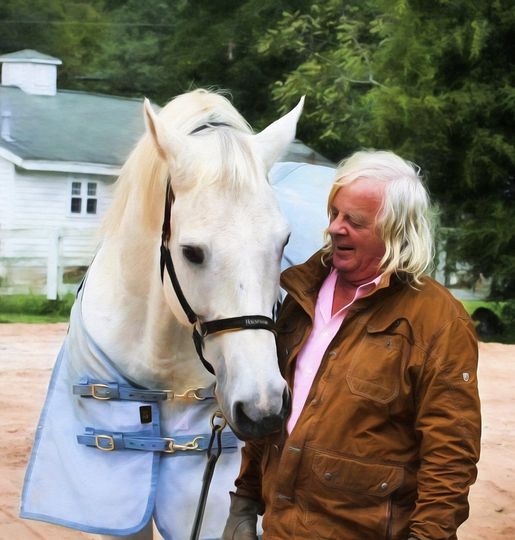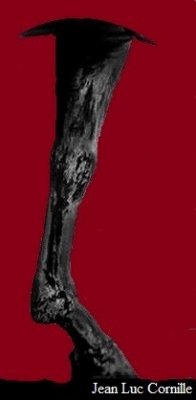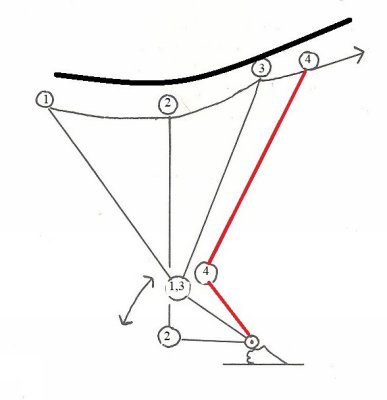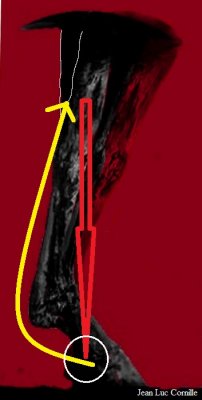Navicular Education

The Science of Motion approach to navicular syndrome identifies and corrects the kinematics abnormality inducing damaging stress on the navicular apparatus and associated soft tissue structures.
At this sequence of the stride, the fetlock is in palmar flexion, going up, and the canon bone became more vertical, opening the angle between the pastern and the canon bone (4). The load on the supporting forelegs is maximum.


Several horses diagnosed with navicular syndrome exhibited the same kinematics abnormality. As the load was maximum on the supporting foreleg's bony column, the canon bone continued its forward rotation instead of opening the angle between the canon bone and the pastern (4). The abnormality increased the tension of the deep digital flexor tendon. The bony column pushed the navicular bone downward, and the advancement of the upper limb pulled on the deep digital flexor tendon upward.
The source of the kinematics abnormality was different for each horse. The horses regained soundness as we corrected the kinematics abnormality.
I superimposed the foreleg in a more inclined position as it was on the horses diagnosed with navicular
syndrome.

The thin white line underlines the normal
position of the front limb by comparison to the more advanced position of the affected horse.
The yellow line illustrates the upward pull on the deep digital flexor tendon.
The direction of the red arrow illustrates the bony column loading the navicular apparatus.
The combination of both forces loads the navicular apparatus and associated soft tissues structures
Our approach to navicular syndrome is to identify and correct the limb kinematics source inducing abnormal stress on the distal sesamoid bone and deep digital flexor tendon and the soft tissue situated below, such as the enthesis connecting the deep digital flexor to the coffin bone. The source of the kinematics abnormality is different for each horse. Consequently, the program is appropriately developed for the horse and the rider. We start with a veterinary report and X-rays. If possible, the report needs to be more detailed than the usual navicular changes. It is helpful to know if the veterinary exam found "Flexor Corticomedullary demarcation, Fragmentation of the distal border, Thinning of the flexor cortex, or other. Good podiatry is necessary. A report of the Farrier is useful with a history of the hoof and what the Farrier did. Then we need the first video for analysis. If we can find the kinematics abnormality loading the navicular apparatus, we explain the kinematics abnormality and its possible cause. There are usually layers of compensation, and our rehabilitation program is based on working together through regular video analysis. From the first analysis, we point to the problem, elaborate a rational hypothesis, address what to address first, and how to do it in hand and/or riding. After a week or more of practice, the horse's reactions will change, and a second video analysis is necessary to decide the adjustments that need to be made. First, we need to stay in close contact as the evolution must be carefully analyzed to determine the correct adjustment. As you learn, you become more capable of thinking in the right direction, and the time between the video analysis becomes wider.
Rehabilitating a horse from a navicular issue is often doable. It is a problem of stress loading the bone and shutting of the remodeling process or damaging the soft tissues. It's a journey that demands commitment, skill, and critical thinking. The first horse that I rehabilitated through this approach took a year as I made many errors. The average for the following twenty-seven horses has been six months. Most of them were ridable. Some were very lame at first, and the rehabilitation started in hand. There are good days, bad days. It is a commitment and a journey.
We have a system of video series. You purchase three video analyses. After the initial analysis, you practice and decide when you need more advice and send us the second video for analysis, and so on. If you need more help, you purchase a second series of three analyses until the horse is sound and you are comfortable to be on your own.
The videos have to be a close view but the whole horse. I need to see details such as the down and up translations of the fetlock, dorsiflexion, and palmar flexion—view from the side. If possible, walk, trot, and canter at the lunge and/or riding. I might ask for a specific view if I need to for the analysis. Slow motions are useless. I need to see the whole body in action and at normal speed.
If you are interested in the journey, contact Helyn for the price and conditions. helyn@scienceofmotion.com
Looking forward to work with you,
Jean Luc Cornille
The Equine Navicular Apparatus as a Premier Enthesis Organ:
Functional Implications" authored by Osborn, Michelle; Cornille, Jean Luc; Blas-Machado, Uriel; Uhl, Elizabeth has been accepted for publication in Veterinary Surgery, under the category Review, based on scientific content and value.


 twitter
twitter facebook
facebook google
google pinterest
pinterest linkedin
linkedin